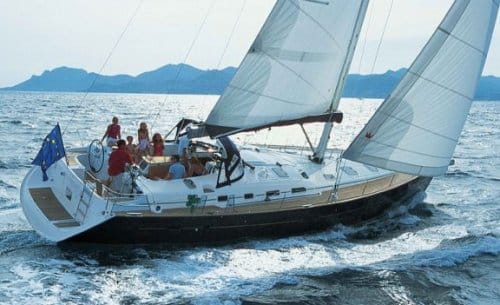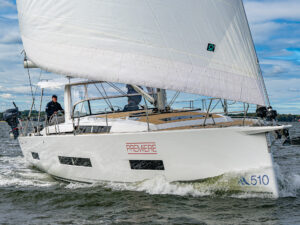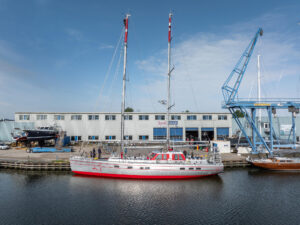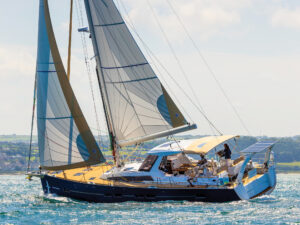
All of the recent Groupe Finot boats designed for Beneteau have been big-even the small ones-and the biggest yet, the Beneteau 523, is enormous. Likewise, it made a big impression on CW’s Boat of the Year judges, who named it Best Full-Size Cruiser for 2006.
Somehow, the 523 manages to avoid looking too big, thanks to Finot’s deftness with proportions-until you see it alongside another 50-footer. Remember the 1966-vintage Columbia 50, in its day the biggest series-produced sailboat? Well, you’d need two Columbias to get the same amount of interior volume.
In fact, there’s so much room below that Beneteau uses it almost wantonly-only two staterooms in 52 feet allows for mighty comfortable living. A three-cabin arrangement is also available for those who wish to share the largesse.
Descending the 523’s companionway, you enter a spacious saloon, which might be a daunting prospect when the boat is in a seaway if not for a counter-height island, connected to the overhead by a handy stainless-steel post.
Immediately to starboard is the nav station, facing forward and flanked by the electric panel and space for instruments. Many people no longer mess with big paper charts, but I think the desk could have been slightly bigger-to accommodate those who still rely on paper-without obstructing passage past it. Besides, most people find a desk useful for all sorts of administrative tasks and as a place to secure a laptop computer and its peripherals.
Forward of the nav station is a settee, divided into easy chairs by what at home you’d call an end table. Opposite is the lounge area; it has a couch outboard and a couple of handsome folding dining chairs inboard of the table.
Of course, such a generous facility must be served by an equally well-laid-out galley. Tucked aft of the chart table and under the cockpit, the galley is amply sized, functional, and secure. The cook can toil away in the worst conditions, well wedged between inboard and outboard counters, and with everything loose contained within deep fiddles. If the outboard and under-counter storage isn’t enough, the “pantry” aft will swallow a year’s worth of legumes and rice as well as beer and wine, while still allowing space for the bosun’s stores. However, the traditional voyager might have some reservations about the smallish, front-opening, under-counter, household-style fridge and the outboard sinks, which might need a pump for port-tack draining.
Both cabins have ample berths. If you travel with kids, you could stack a cord of them in the aft cabin on the almost-king-size mattress. The aft head, which doubles as the day head in this layout, is seaworthy and has a separate stall shower ideally placed to receive wet foul-weather gear. Forward, the island queen berth has easy access and is surrounded by stowage of all kinds. Its head is private, and it has a stall shower, too.
Throughout the interior, the precision-made furniture is well-placed, well-proportioned, and easy on the eye. Beneteau really sets the bar high in this aspect of its manufacturing. Particularly pleasing on this boat was the cabin sole, which, in a break from marine tradition, has the hardwood-floor look of a high-end home. The result is a perfectly smooth surface with no interruptions by lift rings-the flush-fitting panels giving access to the fuel and water tanks beneath are extracted using a vacuum-cup device, something we’ve seen recently on other European models. If you’re waiting for the “but” at the end of the paragraph, here it is: As on many boats, be sure these floorboards are well secured before you head offshore.
Abovedecks on the 523, Beneteau has applied its long experience with the same precision as below. The foredeck sports a vertical windlass that services twin anchor rollers on the stemhead fitting. The deep chain locker is watertight to the boat, and its hatch is offset so the starboard rode doesn’t interfere with its opening. The side decks are clean, with jib-sheet tracks well inboard by the cabin trunk. Beefy mooring cleats are mounted on the teak cap that covers the low bulwark incorporating the hull/deck joint. The mast rails are a welcome detail, though with every conceivable line led to the cockpit, they’re almost redundant.
Finot has created huge volume beneath an artfully low coachroof, and thereby introduced another “but.” To clear the cockpit and the bimini above it, the boom is high, and Beneteau has provided three steps on the mast to give you access to attach the halyard to the sail and operate the sail-pack zipper. A few years ago, the gymnastics involved wouldn’t have fazed me, but today I’d appreciate a fourth step, opposite the third, and a couple of firm handholds so I’d feel more secure while I attend to those tasks.
Under sail, the Beneteau 523 reveals its racing genealogy, making an effortless 8 knots or so in the 12 to 15 knots of breeze we encountered on Chesapeake Bay and showing no inclination to fight the helm. The inboard sheeting, aided by shroud bases in the middle of the side decks, helped the boat tack easily through 90 degrees. Given the wholesome traveler, the full-battened mainsail, and the 7-foot-6-inch draft (a 6-foot-2-inch draft is an option), a crew intent on making the anchorage by lunchtime would have no problems.
Twin steering stations-almost de rigueur on today’s broad-beamed boats-let the helmsman see the jib telltales, whether sitting to windward or to leeward, and the low coachroof permits a clear view forward.
On the 523, the jib sheets lead to primary winches by Harken mounted inboard of, and conveniently close to, the helm stations. For greater convenience, they can be ordered with electric power. The utility winch, to port of the companionway, is electric and is a standard item. Among the seven lines it serves via a battery of Spinlock rope clutches are the main halyard and the mainsheet.
This cruising boat’s cockpit functions well as both work space and living room. Wide, deep-backed seats provide security and support in both roles, and the permanent table provides bracing and a handy repository for loose gear and personal items. With its drop leaves raised, it can field a banquet. A pair of doors across the aft end of the cockpit well open to provide access to the large swim platform in the scoop transom.
When it comes to putting a cruising boat together, Beneteau favors solid laminates for the hull. A fiberglass grid bonded to the inside of the hull provides structural stiffness and also serves as a key for installing internal components. This grid is laid up in a mold and presents a gelcoated surface to the interiors of storage bins behind the saloon settees and in other places.
Under the sole, the compartments not occupied by fuel or water tanks are connected to each other by limber holes and to the bilge pump by a network of pipes. It’s an arrangement necessitated by the hull’s shape-it has no salient sump. (Curiously, we never located the bilge pump; subsequently, we learned that it’s under the floorboards, located just aft of the main bulkhead.)
A balsa core stiffens the deck structure. The depth of the deck-hatch recesses in the overhead hints at the three transverse beams that support the saloon coachroof.
The engine, a 100-horsepower Yanmar, provided ample power, driving the boat at over 8 knots at the suggested 2,800 cruising rpm, but at a higher noise level (83 decibels) than many of the boats the BOTY team looked at. With a conventional shaft and propeller, the Beneteau 523 may be at a slight disadvantage in that respect to boats with smaller engines and saildrive units. A standard bow thruster makes up for any maneuvering tics the conventional prop setup might initiate. Tucked under the companionway-ladder assembly, which hinges up and is supported on air springs, the engine and its accessories are easy to work on.
Access to the steering system is through lockers under the helm seats. Beefy, glassed-over flanges support the rudder tube, which extends almost up to the cockpit sole, just leaving room for the quadrant at the rudder head. There is no redundancy in the two steering wheels, because they drive the quadrant via a common cable. However, the autopilot (an option) connects directly to the quadrant, so it will steer the boat should the cable fail. The emergency tiller fits into the head of the composite rudderstock through a deck plate, and thanks to the twin wheels, it has room to swing.
When the BOTY judges were summing up their impressions of the 523, they agreed that it “hit the cruiser’s sweet spot” in many ways, from the generous living accommodations to the cockpit to the sails to how it handled under sail and under power.
In the configuration presented, with no dedicated sea berth, it wasn’t set up for voyaging, but it’s certainly capable of being taken offshore. It would be an excellent vehicle aboard which to enjoy both the sailing while “getting there” and the ambience of “being there.”
Almost as an afterthought, when the BOTY crew had put the 523 through both its sailing and motoring tests, Garth Hitchins, who, as the Beneteau dealer in Annapolis, Maryland, gets to put on the BOTY show-and-tell, opened the hatch on the foredeck.
“You can put what you like in here,” he said, gesturing at the generous “crew” cabin that’s separated from the forward stateroom by a full bulkhead. “In this boat, we fitted a workbench and a couple of pipe cots just as an example of what you can do.”
At $465,000, not only does the Beneteau 523 come ready for luxurious coastal cruising; it also brings with it the potential for going deep sea in style.
Jeremy McGeary is a Cruising World contributing editor
Beneteau 523
LOA 52′ 2″ (15.89 m.)
LWL 48′ 0″ (14.63 m.)
Beam 16′ 1″ (4.90 m.)
Draft 7′ 6″ (2.30 m.)
Sail Area (100%) 1,342 sq. ft. (124.7 sq. m.)
Ballast 9,680 lb. (4,391 kg.)
Displacement 34,265 lb. (15,575 kg.)
Ballast/D .28
D/L 138
SA/D 20.4
Water 251 gal. (950 l.)
Fuel 119 gal. (450 l.)
Mast Height 72′ 0″ (21.94 m.)
Engine Yanmar 100-hp. diesel
Designer Groupe Finot
Sailaway Base Price $465,000
Contact Beneteau USA, (848) 629-5300
To read more Cruising World reviews of Beneteau sailboats, click here. To visit Beneteau America’s website, click here.








